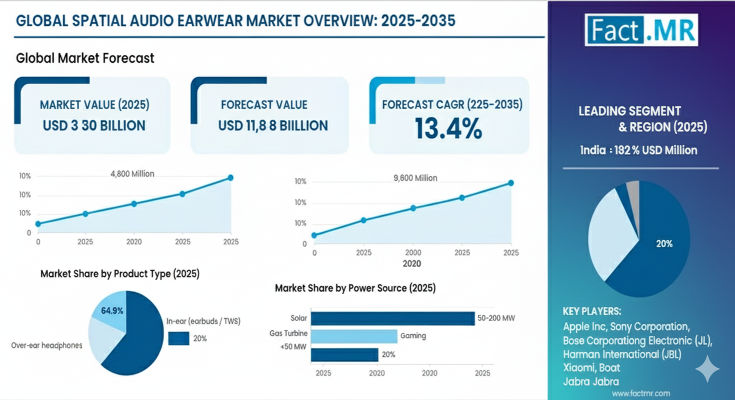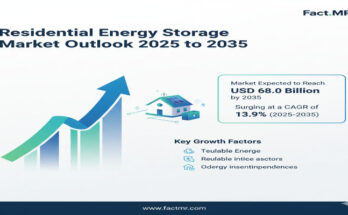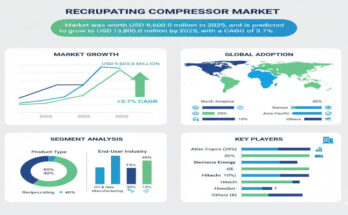As the world accelerates toward net-zero emissions, the small wind market is harnessing the power of compact turbines to deliver clean, decentralized energy to homes and businesses. A new report from Fact.MR projects the global market, valued at US$ 1,200.0 million in 2025, to reach US$ 2,400.0 million by 2035, reflecting a steady compound annual growth rate (CAGR) of 7.2%. This doubling in value over the decade—adding US$ 1,200.0 million—signals a robust shift toward distributed generation, where small wind systems (<100 kW) play a key role in energy independence and grid resilience.
With horizontal axis wind turbines (HAWT) leading the charge and onshore applications dominating, the sector is benefiting from falling costs and supportive policies. “Small wind is no longer a niche—it’s a scalable solution for the energy transition, blending efficiency with accessibility for residential and commercial users,” said Marcus Hale, Senior Energy Analyst at Fact.MR. “As governments worldwide prioritize renewables, this market’s 7.2% CAGR underscores its potential to power sustainable communities without the footprint of large-scale farms.”
Key Drivers: Distributed Energy Boom and Policy Momentum
The market’s expansion is driven by surging demand for distributed energy in residential (40.0% share) and commercial (35.0%) sectors, where small wind complements solar for hybrid setups. Government initiatives, including tax incentives and renewable targets, are pivotal—India’s programs in urban centers like Mumbai and Delhi, for instance, are spurring 8.0% CAGR. Technological advancements in turbine aerodynamics and power conversion systems boost efficiency to 85-95%, making small wind cost-competitive.
On-grid systems (60.0% share) enable seamless utility integration, while off-grid (40.0%) solutions thrive in remote areas. However, high R&D costs and regulatory hurdles in developing regions pose challenges, though education for energy contractors is addressing these gaps.
Segmentation Insights: HAWT Dominance and Onshore Focus
Fact.MR’s analysis highlights clear leaders. By product type, HAWT holds 70.0% share in 2025, thanks to superior multi-directional wind capture and aerodynamic designs. Vertical axis (VAWT) follows at 30.0%, valued for urban flexibility and low-wind performance.
Applications emphasize onshore deployments, with residential leading at 40.0% for home energy autonomy, commercial at 35.0% for business sustainability, and industrial at 25.0% for process power. Grid type favors on-grid (60.0%) for energy diversity, while off-grid supports isolated needs.
Regional Dynamics: Asia-Pacific’s Rapid Rise Challenges Europe’s Maturity
Asia-Pacific is the growth engine, with India at 8.0% CAGR driven by distributed infrastructure in Bangalore and Chennai, and China at 7.8% via Belt and Road renewable modernizations in Shanghai and Guangzhou. These markets are expanding 12-15% annually in renewables.
Europe maintains strength, valued at US$ 1,096.0 million in 2025 (with Germany at US$ 280.0 million, 25.5% share, and 6.5% CAGR via innovations in Berlin and Munich). The UK follows at US$ 200.0 million (18.2% share, 6.4% CAGR) with energy upgrades in London and Manchester.
North America, led by the USA’s 6.8% CAGR and federal investments in western states, benefits from grid-compatible systems. South Korea (6.3% CAGR) and Japan (6.0%, with 75.0% HAWT share) round out key players, while Latin America and Middle East & Africa offer untapped potential through green financing.
Recent Developments: Innovations and Strategic Collaborations
The sector is buzzing with progress. In 2024, Bergey Windpower launched advanced HAWT models with integrated storage, achieving 90% efficiency in U.S. pilots. Bornay Aerogeneradores expanded VAWT offerings in Europe, partnering with German utilities for urban deployments in Frankfurt. China’s 2025 initiatives include subsidies for small wind in Shenzhen, boosting off-grid adoption by 20%. Trends point to AI-enhanced controls and hybrid integrations, with year-over-year growth accelerating 55.2% in the latter half of the decade.
Key Players Insights: Leaders Innovating for Efficiency and Scale
A moderately concentrated landscape of 15-20 players sees top firms controlling 25-35% share through R&D and global networks:
-
Bergey Windpower Co.: Dominates HAWT with high-efficiency designs, focusing on U.S. residential markets and service excellence.
-
Bornay Aerogeneradores S.L.: Specializes in VAWT for Europe, emphasizing urban installations and compliance in Spain and Germany.
-
Kingspan Group plc: Leverages commercial applications, expanding on-grid solutions across North America and Asia.
-
Ryse Energy Ltd.: Innovates in hybrid systems, targeting Canada’s off-grid segments with durable turbines.
-
Northern Power Systems Corp.: Focuses on industrial onshore, with AI controls boosting 85-95% conversion rates.
-
Eocycle Technologies Inc.: Advances VAWT tech for harsh environments, gaining in Canada and Europe.
-
SD Wind Energy Ltd. and Primus Wind Power, LLC: Prioritize small-scale residential, with U.S.-centric affordability.
-
Aeolos Wind Energy Ltd., Zephyr Corporation, XZERES Wind Corp.: Regional challengers in Asia and North America, customizing for local winds.
-
Windspot S.L., Unitron Energy Pvt. Ltd., Ogin Inc., Kliux Energies S.L.: Excel in Europe and India, via partnerships for regulatory navigation.
Competition hinges on innovation and after-sales support, with M&A targeting storage integrations.
Challenges and Opportunities: Overcoming Costs with Hybrid Synergies
High R&D expenses and approval complexities restrain growth, particularly in emerging markets needing technical education. “Regulatory harmonization is key to unlocking small wind’s full potential,” Hale observed.
Opportunities shine in energy storage pairings and monitoring tech, enhancing ROI. Government R&D funding and skills training will drive 44.8% growth in the first half-decade, positioning small wind as a disruptor against larger renewables.
Browse Full Report: https://www.factmr.com/report/small-wind-market
Future Outlook: A $2.4 Billion Decentralized Power Horizon
By 2035, Fact.MR envisions small wind integral to distributed grids, with HAWT efficiencies nearing 95% and Asia-Pacific leading adoption. As renewables grow 12-15% yearly, stakeholders must invest in collaborations to capture this clean energy wave.
This Fact.MR report arrives amid global policy pushes, equipping leaders with strategies for wind-powered sustainability.



